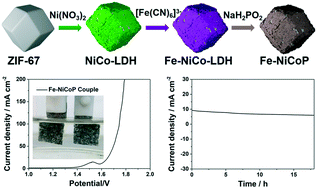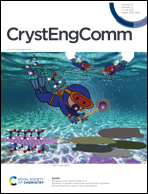Facile formation of Fe-doped NiCoP hollow nanocages as bifunctional electrocatalysts for overall water splitting†
Abstract
Rational design of electrocatalysts with unique morphological structures and chemical compositions is crucial for electrochemical performance and energy storage capacity. In this work, an Fe-doped NiCoP hybrid hollow nanocage (denoted as Fe-NiCoP) was synthesized through the phosphorization of the product from [Fe(CN)6]3−-intercalated NiCo-LDH (layered double hydroxide), where the original ZIF-67-Co was used as the template. Because of the hollow nanostructure and the synergistic effect between multiple components, the Fe-NiCoP catalyst exhibited promising hydrogen evolution reaction (HER) and oxygen evolution reaction (OER) activities in 1.0 M KOH with low overpotentials of 147 and 235 mV at 10 mA cm−2, respectively. Furthermore, the Fe-NiCoP catalyst only achieved a current density of 10 mA cm−2 at the voltage of 1.60 V. Inspired by the excellent OER performance of the Fe-NiCoP catalyst, a Zn–air battery was built to explore the Fe-NiCoP catalyst for practical application. After 900 successive cycles, the Fe-NiCoP + Pt/C catalysts exhibited excellent cycling stability at 5 mA cm−2, which was a much stronger performance than that of the RuO2 + Pt/C catalysts. This work provides a practical strategy for the synthesis of high-performance and low-cost electrocatalysts.

- This article is part of the themed collections: Nanomaterials and Editor’s Collection: Imperfect nanocrystals for Perfect Catalysis


 Please wait while we load your content...
Please wait while we load your content...